.jpg.webp)
This list of birds of Wales includes every species of bird that has been recorded in a wild state in Wales. Compared to the avifauna of Britain as a whole, Wales has fewer breeding species, but these include a number of moorland species such as red grouse and black grouse, large numbers of seabirds (particularly on offshore islands such as Skomer, Grassholm and Bardsey) and good populations of several species typical of Welsh oak woods including redstart, pied flycatcher and wood warbler.[2][3] Among the birds of prey is the red kite, which had become extinct in other parts of Britain until being reintroduced recently.[1] In winter many wildfowl and waders are found around the coast, attracted by the mild temperatures.[2] In spring and autumn a variety of migrant and vagrant birds can be seen, particularly on headlands and islands.[2] Three-quarters of the UK population of the red-billed chough resides in Wales.
The list is based on Birds in Wales (Lovegrove et al. 1994), Birds in Wales 1992–2022 (Green 2022) and the list of the Welsh Ornithological Society (Prater & Thorpe 2006) with updates from the Welsh Records Panel's annual reports. The taxonomy and scientific names follow the official list of the British Ornithologists' Union (BOU).[4] The English names are the vernacular names used in the 7th edition of the BOU list with the standardized names from that list given in brackets where they differ.[5] The family introductions are based on The New Encyclopedia of Birds (Perrins 2004) except where otherwise stated.
Certain categories of birds are noted with the following tags:
- (A) Accidental - a species that rarely or accidentally occurs in Wales
- (I) Introduced - a species introduced to Wales as a consequence, direct or indirect, of human actions
The total number of species on the list is 463 and 10 introduced species. About 150 species breed annually.[2]
Ducks, geese and swans
.jpg.webp)
.jpg.webp)

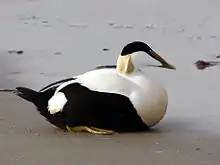
Order: Anseriformes Family: Anatidae
The swans, ducks and geese are medium to large birds that are adapted to an aquatic existence with webbed feet and bills which are flattened to a greater or lesser extent. In many ducks the male is colourful while the female is dull brown. The diet consists of a variety of animals and plants. The family is well represented in Wales, especially in winter when large numbers visit from Greenland, Scandinavia and Russia.[2]
| Common name | Binomial | Status |
|---|---|---|
| Brent goose | Branta bernicla | |
| Red-breasted goose | Branta ruficollis | |
| Canada goose | Branta canadensis | I |
| Barnacle goose | Branta leucopsis | |
| Greylag goose | Anser anser | |
| Taiga bean goose | Anser fabalis | (A) |
| Pink-footed goose | Anser brachyrhynchus | |
| Tundra bean goose | Anser serrirostris | (A) |
| White-fronted goose | Anser albifrons | |
| Lesser white-fronted goose | Anser erythropus | (A) |
| Mute swan | Cygnus olor | |
| Bewick's swan | Cygnus columbianus | |
| Whooper swan | Cygnus cygnus | |
| Egyptian goose | Alopochen aegyptiacus | I[10] |
| Shelduck | Tadorna tadorna | |
| Ruddy shelduck | Tadorna ferruginea | (A) |
| Mandarin duck | Aix galericulata | I |
| Garganey | Spatula querquedula | |
| Blue-winged teal | Spatula discors | (A) |
| Shoveler | Spatula clypeata | |
| Gadwall | Mareca strepera | |
| Falcated duck | Mareca falcata | |
| Wigeon | Anas penelope | |
| American wigeon | Mareca americana | (A) |
| Mallard | Anas platyrhynchos | |
| Black duck | Anas rubripes | (A) |
| Pintail | Anas acuta | |
| Teal | Anas crecca | |
| Green-winged teal | Anas carolinensis | (A) |
| Red-crested pochard | Netta rufina | I |
| Pochard | Aythya ferina | |
| Ferruginous duck | Aythya nyroca | (A) |
| Ring-necked duck | Aythya collaris | (A) |
| Tufted duck | Aythya fuligula | |
| Scaup | Aythya marila | |
| Lesser scaup | Aythya affinis | (A)[11] |
| King eider | Somateria spectabilis | (A) |
| Eider | Somateria mollissima | |
| Surf scoter | Melanitta perspicillata | (A) |
| Velvet scoter | Melanitta fusca | |
| Common scoter | Melanitta nigra | |
| Black scoter | Melanitta americana | (A) |
| Long-tailed duck | Clangula hyemalis | |
| Goldeneye | Bucephala clangula | |
| Smew | Mergellus albellus | |
| Hooded merganser | Lophodytes cucullatus | (A) |
| Goosander | Mergus merganser | |
| Red-breasted merganser | Mergus serrator | |
| Ruddy duck | Oxyura jamaicensis | I |
Pheasants, grouse, and allies
Order: Galliformes Family: Phasianidae
These are terrestrial species, feeding and nesting on the ground. They are variable in size but generally plump, with broad and relatively short wings.
| Common name | Binomial | Status |
|---|---|---|
| Red grouse | Lagopus lagopus | |
| Black grouse | Lyrurus tetrix | |
| Grey partridge | Perdix perdix | |
| Pheasant | Phasianus colchicus | I |
| Quail | Coturnix coturnix | |
| Red-legged partridge | Alectorix rufa | I |
Nightjars and allies
Order: Caprimulgiformes Family: Caprimulgidae
Nightjars are medium-sized nocturnal birds that usually nest on the ground. They have long wings, short legs and very short bills. Their soft plumage is cryptically coloured to resemble bark or leaves.
| Common name | Binomial | Status |
|---|---|---|
| Common nighthawk | Chordeiles minor | (A) |
| Nightjar | Caprimulgus europaeus |
Swifts
Order: Apodiformes Family: Apodidae
The swifts are small birds which spend the majority of their lives flying. These birds have very short legs and never settle voluntarily on the ground, perching instead only on vertical surfaces.
| Common name | Binomial | Status |
|---|---|---|
| Chimney swift | Chaetura pelagica | (A)[12] |
| Alpine swift | Apus melba | (A) |
| Swift | Apus apus | |
| Pallid swift | Apus pallidus | (A) |
| Little swift | Apus affinis | (A) |
Bustards
Order: Otidiformes Family: Otididae
Large, sturdy birds of open plains with long legs and necks and strong feet.
| Common name | Binomial | Status |
|---|---|---|
| Great bustard | Otis tarda | (A) |
| Little bustard | Tetrax tetrax | (A) |
Cuckoos
Order: Cuculiformes Family: Cuculidae
Birds of variable size with slender bodies and long tails. Some species are known for laying their eggs in the nests of other birds.
| Common name | Binomial | Status |
|---|---|---|
| Great spotted cuckoo | Clamator glandarius | (A) |
| Yellow-billed cuckoo | Coccyzus americanus | (A) |
| Cuckoo | Cuculus canorus |
Sandgrouse
Order: Pterocliformes Family: Pteroclidae
Sturdy, medium-sized birds with a small head and long, pointed wings.
| Common name | Binomial | Status |
|---|---|---|
| Pallas's sandgrouse | Syrrhaptes paradoxus | (A) |
Pigeons and doves
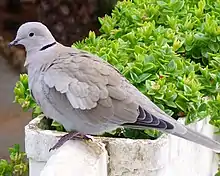
Order: Columbiformes Family: Columbidae
Pigeons and doves are stout-bodied birds with short necks and short slender bills with a fleshy cere.
| Common name | Binomial | Status |
|---|---|---|
| Rock dove | Columba livia | |
| Stock dove | Columba oenas | |
| Woodpigeon | Columba palumbus | |
| Turtle dove | Streptopelia turtur | |
| Collared dove | Streptopelia decaocto |
Rails, gallinules, and coots
Order: Gruiformes Family: Rallidae
These birds mainly occupy dense vegetation in damp environments near lakes, marshes or rivers. Many are shy and secretive birds, making them difficult to observe. Most species have strong legs and long toes which are well adapted to soft uneven surfaces.
| Common name | Binomial | Status |
|---|---|---|
| Water rail | Rallus aquaticus | |
| Corncrake | Crex crex | (A) |
| Sora | Porzana carolina | (A) |
| Spotted crake | Porzana porzana | (A) |
| Moorhen | Gallinula chloropus | |
| Coot | Fulica atra | |
| Baillon's crake | Porzana pusilla | (A) |
| Little crake | Porzana parva | (A) |
Cranes
Order: Gruiformes Family: Gruidae
Cranes are large, long-legged and long-necked birds. Unlike the similar-looking but unrelated herons, cranes fly with necks outstretched, not pulled back. Most have elaborate and noisy courting displays or "dances".
| Common name | Binomial | Status |
|---|---|---|
| Crane | Grus grus | (A) |
Grebes

Order: Podicipediformes Family: Podicipedidae
Grebes are small to medium-large diving birds with lobed toes and pointed bills. They are seen mainly on lowland waterbodies and coasts. They feed on aquatic animals and nest on a floating platform of vegetation.
| Common name | Binomial | Status |
|---|---|---|
| Little grebe | Tachybaptus ruficollis | |
| Pied-billed grebe | Podilymbus podiceps | (A) |
| Red-necked grebe | Podiceps grisegena | |
| Great crested grebe | Podiceps cristatus | |
| Slavonian grebe | Podiceps auritus | |
| Black-necked grebe | Podiceps nigricollis |
Stone-curlews
Order: Charadriiformes Family: Burhinidae
A small family of medium to large waders with strong black bills, large yellow eyes and cryptic plumage.
| Common name | Binomial | Status |
|---|---|---|
| Stone-curlew | Burhinus oedicnemus | (A) |
Oystercatchers

Order: Charadriiformes Family: Haematopodidae
The oystercatchers are large, obvious and noisy wading birds with strong bills used for smashing or prising open molluscs.
| Common name | Binomial | Status |
|---|---|---|
| Oystercatcher | Haematopus ostralegus |
Stilts and avocets
Order: Charadriiformes Family: Recurvirostridae
A family of fairly large wading birds. The avocets have long legs and long up-curved bills. The stilts have extremely long legs and long, thin, straight bills.
| Common name | Binomial | Status |
|---|---|---|
| Black-winged stilt | Himantopus himantopus | (A) |
| Avocet | Recurvirostra avosetta |
Plovers and lapwings
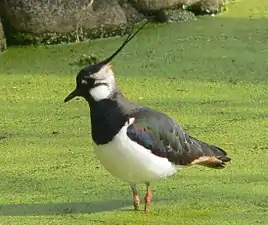
Order: Charadriiformes Family: Charadriidae
Small to medium-sized wading birds with compact bodies, short, thick necks and long, usually pointed, wings.
| Common name | Binomial | Status |
|---|---|---|
| Lapwing | Vanellus vanellus | |
| Sociable plover | Vanellus gregarius | (A) |
| Golden plover | Pluvialis apricaria | |
| Pacific golden plover | Pluvialis fulva | (A) |
| American golden plover | Pluvialis dominica | (A) |
| Grey plover | Pluvialis squatarola | |
| Ringed plover | Charadrius hiaticula | |
| Little ringed plover | Charadrius dubius | |
| Killdeer | Charadrius vociferus | (A) |
| Kentish plover | Charadrius alexandrinus | (A) |
| Greater sand plover | Charadrius leschenaultii | (A) |
| Dotterel | Charadrius morinellus |
Sandpipers and allies

.jpg.webp)
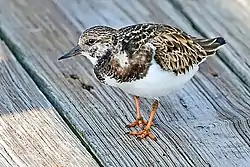
Order: Charadriiformes Family: Scolopacidae
A large, diverse family of wading birds. Different lengths of legs and bills enable multiple species to feed in the same habitat, particularly on the coast, without direct competition for food.
| Common name | Binomial | Status |
|---|---|---|
| Upland sandpiper | Bartramia longicauda | (A) |
| Whimbrel | Numenius phaeopus | |
| Hudsonian whimbrel | Numenius hudsonicus | (A) |
| Little whimbrel | Numenius minutus | (A) |
| Curlew | Numenius arquata | |
| Bar-tailed godwit | Limosa lapponica | |
| Black-tailed godwit | Limosa limosa | |
| Turnstone | Arenaria interpres | |
| Knot | Calidris canutus | |
| Ruff | Calidris pugnax | |
| Broad-billed sandpiper | Calidris falcinellus | (A) |
| Sharp-tailed sandpiper | Calidris acuminata | (A) |
| Stilt sandpiper | Calidris himantopus | (A)[19] |
| Curlew sandpiper | Calidris ferruginea | |
| Temminck's stint | Calidris temminckii | (A) |
| Sanderling | Calidris alba | |
| Dunlin | Calidris alpina | |
| Purple sandpiper | Calidris maritima | |
| Baird's sandpiper | Calidris bairdii | (A) |
| Little stint | Calidris minuta | |
| Least sandpiper | Calidris minutilla | (A) |
| White-rumped sandpiper | Calidris fuscicollis | (A) |
| Buff-breasted sandpiper | Calidris subruficollis | (A) |
| Pectoral sandpiper | Calidris melanotos | (A) |
| Semipalmated sandpiper | Calidris pusilla | (A) |
| Long-billed dowitcher | Limnodromus scolopaceus | |
| Woodcock | Scolopax rusticola | |
| Jack snipe | Lymnocryptes minimus | |
| Great snipe | Gallinago minima | (A) |
| Snipe | Gallinago gallinago | |
| Terek sandpiper | Xenus cinerea | (A) |
| Wilson's phalarope | Phalaropus tricolor | (A) |
| Red-necked phalarope | Phalaropus lobatus | (A) |
| Grey phalarope | Phalaropus fulicarius | |
| Common sandpiper | Actitis hypoleucos | |
| Spotted sandpiper | Tringa macularius | (A) |
| Green sandpiper | Tringa ochropus | |
| Grey-tailed tattler | Tringa brevipes | (A) |
| Lesser yellowlegs | Tringa flavipes | (A) |
| Redshank | Tringa totanus | |
| Marsh sandpiper | Tringa stagnatilis | (A) |
| Wood sandpiper | Tringa glareola | |
| Spotted redshank | Tringa erythropus | |
| Greenshank | Tringa nebularia | |
| Greater yellowlegs | Tringa melanoleuca | (A) |
Pratincoles and coursers
Order: Charadriiformes Family: Glareolidae
A family of slender, long-winged wading birds.
| Common name | Binomial | Status |
|---|---|---|
| Cream-coloured courser | Cursorius cursor | (A) |
| Collared pratincole | Glareola pratincola | (A) |
| Black-winged pratincole | Glareola nordmanni | (A) |
Gulls, terns, and skimmers
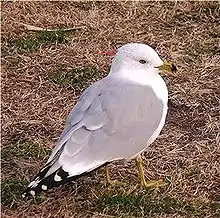
Order: Charadriiformes Family: Laridae
Medium to large seabirds with grey, white and black plumage, webbed feet and strong bills. Many are opportunistic and adaptable feeders.
| Common name | Binomial | Status |
|---|---|---|
| Kittiwake | Rissa tridactyla | |
| Ivory gull | Pagophila eburnea | (A) |
| Sabine's gull | Xema sabini | |
| Bonaparte's gull | Chroicocephalus philadelphia | (A) |
| Black-headed gull | Chroicocephalus ridibundus | |
| Little gull | Hydrocoloeus minutus | |
| Ross's gull | Rhodostethia rosea | (A) |
| Laughing gull | Leucophaeus atricilla | (A) |
| Franklin's gull | Leucophaeus pipixcan | (A) |
| Mediterranean gull | Ichthyaetus melanocephalus | |
| Common gull | Larus canus | |
| Ring-billed gull | Larus delawarensis | |
| Great black-backed gull | Larus marinus | |
| Glaucous-winged gull | Larus glaucescens | (A) |
| Glaucous gull | Larus hyperboreus | |
| Iceland gull | Larus glaucoides | |
| Herring gull | Larus argentatus | |
| Caspian gull | Larus cachinnans | (A) |
| Yellow-legged gull | Larus michahellis | (A) |
| Lesser black-backed gull | Larus fuscus | |
| Gull-billed tern | Gelochelidon nilotica | (A) |
| Caspian tern | Hydroprogne caspia | (A) |
| Royal tern | Thalasseus maximus | (A) |
| Lesser crested tern | Thalasseus bengalensis | (A) |
| Sandwich tern | Thalasseus sandvicensis | |
| Elegant tern | Thalasseus elegans | (A) |
| Little tern | Sternula albifrons | |
| Bridled tern | Onychoprion anaethetus | (A) |
| Sooty tern | Onychoprion fuscatus | (A) |
| Roseate tern | Sterna dougallii | |
| Common tern | Sterna hirundo | |
| Arctic tern | Sterna paradisaea | |
| Forster's tern | Sterna forsteri | (A) |
| Whiskered tern | Chlidonias hybrida | (A) |
| White-winged black tern | Chlidonias leucoptera | (A) |
| Black tern | Chlidonias niger |
Skuas
Order: Charadriiformes Family: Stercorariidae
Medium to large seabirds with mainly grey or brown plumage, sharp claws and a hooked tip to the bill. They chase other seabirds to force them to drop their catches.
| Common name | Binomial | Status |
|---|---|---|
| South Polar skua | Stercorarius maccormicki | |
| Great skua | Stercorarius skua | |
| Pomarine skua | Stercorarius pomarinus | |
| Arctic skua | Stercorarius parasiticus | |
| Long-tailed skua | Stercorarius longicaudus |
Auks, murres, and puffins
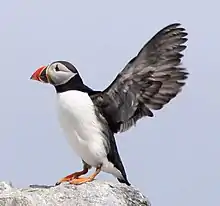
Order: Charadriiformes Family: Alcidae
A family of seabirds which are superficially similar to penguins with their black-and-white colours, their upright posture and some of their habits but which are able to fly. Great auks are extinct.
| Common name | Binomial | Status |
|---|---|---|
| Little auk | Alle alle | |
| Common guillemot | Uria aalge | |
| Razorbill | Alca torda | |
| Black guillemot | Cepphus grylle | |
| Puffin | Fratercula arctica |
Divers
Order: Gaviiformes Family: Gaviidae
Divers are aquatic birds the size of a large duck, to which they are unrelated. They swim well and fly adequately but are almost hopeless on land, because their legs are placed towards the rear of the body. They feed on fish and other aquatic animals. They are all non-breeding visitors in Wales.
| Common name | Binomial | Status |
|---|---|---|
| Red-throated diver | Gavia stellata | |
| Black-throated diver | Gavia arctica | |
| Great northern diver | Gavia immer | |
| White-billed diver | Gavia adamsii | (A) |
Southern storm petrels
Order: Procellariiformes Family: Oceanitidae
The austral storm petrels are the smallest seabirds, feeding on plankton and small fish picked from the surface, typically while hovering. They nest in colonies on the ground, most often in burrows.
| Common name | Binomial | Status |
|---|---|---|
| Wilson's storm petrel | Oceanites oceanicus | (A) |
Albatrosses
Order: Procellariiformes Family: Diomedeidae
The albatrosses are among the largest flying birds with long, narrow wings for gliding. The majority are found in the Southern Hemisphere with only vagrants occurring in the North Atlantic.
| Common name | Binomial | Status |
|---|---|---|
| Black-browed albatross | Thalassarche melanophris | (A) |
Northern storm petrels
Order: Procellariiformes Family: Hydrobatidae
The northern storm petrels are the smallest seabirds, feeding on plankton and small fish picked from the surface, typically while hovering. They nest in colonies on the ground, most often in burrows.
| Common name | Binomial | Status |
|---|---|---|
| Storm petrel | Hydrobates pelagicus | |
| Leach's petrel | Hydrobates leucorrhous |
Petrels and shearwaters
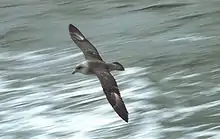
Order: Procellariiformes Family: Procellariidae
These are highly pelagic birds with long, narrow wings and tube-shaped nostrils. They feed at sea on fish, squid and other marine life. They come to land to breed in colonies, nesting in burrows or on cliffs.
| Common name | Binomial | Status |
|---|---|---|
| Fulmar | Fulmarus glacialis | |
| Cory's shearwater | Calonectris borealis | (A) |
| Sooty shearwater | Ardenna griseus | |
| Great shearwater | Ardenna gravis | (A) |
| Manx shearwater | Puffinus puffinus | |
| Balearic shearwater | Puffinus mauretanicus | |
| Macaronesian shearwater | Puffinus baroli | (A) |
Storks
Order: Ciconiiformes Family: Ciconiidae
Storks are large, heavy, long-legged, long-necked wading birds with long stout bills and wide wingspans. They fly with the neck extended.
| Common name | Binomial | Status |
|---|---|---|
| Black stork | Ciconia nigra | (A) |
| White stork | Ciconia ciconia | (A) |
Boobies and gannets

Order: Suliformes Family: Pelecanidae
Gannets are large seabirds that plunge-dive for fish and nest in large colonies. They have a torpedo-shaped body, long, narrow, pointed wings and a fairly long tail.
| Common name | Binomial | Status |
|---|---|---|
| Gannet | Morus bassanus |
Cormorants and shags
Order: Suliformes Family: Phalacrocoracidae
Cormorants are medium to large aquatic birds with mainly dark plumage and areas of coloured skin on the face. The bill is long, thin and sharply hooked for catching fish and aquatic invertebrates. They nest in colonies, usually by the sea.
| Common name | Binomial | Status |
|---|---|---|
| Cormorant | Phalacrocorax carbo | |
| Shag | Gulosus aristotelis |
Ibises and spoonbills
Order: Pelecaniformes Family: Threskiornithidae
A family of long-legged, long-necked wading birds. Ibises have long, curved bills. Spoonbils have a flattened bill, wider at the tip.
| Common name | Binomial | Status |
|---|---|---|
| Glossy ibis | Plegadis falcinellus | (A) |
| Spoonbill | Platalea leucorodia |
Herons and bitterns
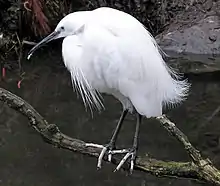
Order: Pelecaniformes Family: Ardeidae
Herons and egrets are medium to large wading birds with long necks and legs. Bitterns tend to be shorter-necked and more secretive. They all fly with their necks retracted. The sharp bill is used to catch fish, amphibians and other animals. Many species nest in colonies, often in trees.
| Common name | Binomial | Status |
|---|---|---|
| Bittern | Botaurus stellaris | |
| American bittern | Botaurus lentiginosus | (A) |
| Little bittern | Ixobrychus minutus | (A) |
| Night heron | Nycticorax nycticorax | (A) |
| Green heron | Butorides virescens | (A)[26] |
| Squacco heron | Ardeola ralloides | (A) |
| Cattle egret | Bubulcus ibis | |
| Grey heron | Ardea cinerea | |
| Purple heron | Ardea purpurea | (A) |
| Great white egret | Ardea alba | (A) |
| Little egret | Egretta garzetta |
Osprey
Order: Accipitriformes Family: Pandionidae
A large fish-eating bird of prey belonging to a family of its own. It is mainly brown above and white below with long, angled wings. It is mainly a passage migrant in Wales but has recently begun to breed.
| Common name | Binomial | Status |
|---|---|---|
| Osprey | Pandion haliaetus |
Hawks, eagles, and kites
.jpg.webp)
Order: Accipitriformes Family: Accipitridae
A family of birds of prey which includes hawks, buzzards, eagles, kites and harriers. These birds have very large powerful hooked beaks for tearing flesh from their prey, strong legs, powerful talons and keen eyesight.
| Common name | Binomial | Status |
|---|---|---|
| Honey-buzzard | Pernis apivorus | |
| Golden eagle | Aquila chrysaetos | (A) |
| Sparrowhawk | Accipiter nisus | |
| Goshawk | Accipiter gentilis | |
| Marsh harrier | Circus aeruginosus | |
| Hen harrier | Circus cyaneus | |
| Pallid harrier | Circus macrourus | (A) |
| Montagu's harrier | Circus pygargus | (A) |
| Red kite | Milvus milvus | |
| Black kite | Milvus migrans | (A) |
| White-tailed eagle | Haliaaetus albicilla | (A) |
| Rough-legged buzzard | Buteo lagopus | (A) |
| Buzzard | Buteo buteo |
Barn owls
.jpg.webp)
Order: Strigiformes Family: Tytonidae
Barn owls are medium-sized to large owls with large heads and characteristic heart-shaped faces. They have long strong legs with powerful talons.
| Common name | Binomial | Status |
|---|---|---|
| Barn owl | Tyto alba |
Owls
Order: Strigiformes Family: Strigidae
Typical owls are small to large solitary nocturnal birds of prey. They have large forward-facing eyes and ears, a hawk-like beak and a conspicuous circle of feathers around each eye called a facial disc.
| Common name | Binomial | Status |
|---|---|---|
| Little owl | Athene noctua | |
| Scops owl | Otus scops | (A) |
| Long-eared owl | Asio otus | |
| Short-eared owl | Asio flammeus | |
| Snowy owl | Bubo scandiaca | (A) |
| Tawny owl | Strix aluco |
Hoopoes
Order: Bucerotiformes Family: Upupidae
A distinctive bird in its own family with a long curved bill, a crest, and black-and-white striped wings and tail.
| Common name | Binomial | Status |
|---|---|---|
| Hoopoe | Upupa epops |
Rollers
Order: Coraciiformes Family: Coraciidae
A small family of colourful, medium-sized, birds with a crow-like shape that feeds mainly on insects.
| Common name | Binomial | Status |
|---|---|---|
| Roller | Coracias garrulus | (A) |
Kingfishers
.jpg.webp)
Order: Coraciiformes Family: Alcedinidae
Kingfishers are medium-sized birds with large heads, long pointed bills, short legs and stubby tails. There are about 93 species worldwide, 2 in Britain and 1 in Wales.
| Common name | Binomial | Status |
|---|---|---|
| Kingfisher | Alcedo atthis |
Bee-eaters
Order: Coraciiformes Family: Meropidae
A group of near-passerine birds characterised by richly coloured plumage, slender bodies and usually elongated central tail feathers.
| Common name | Binomial | Status |
|---|---|---|
| Bee-eater | Merops apiaster | (A) |
Woodpeckers
.jpg.webp)
Order: Piciformes Family: Picidae
Woodpeckers are small to medium-sized birds with chisel-like beaks, short legs, stiff tails and long tongues used for capturing insects. Many woodpeckers have the habit of tapping noisily on tree trunks with their beaks.
| Common name | Binomial | Status |
|---|---|---|
| Wryneck | Jynx tranquila | |
| Lesser spotted woodpecker | Dryobates minor | |
| Great spotted woodpecker | Dendrocopos major | |
| Green woodpecker | Picus viridis |
Falcons and caracaras

Order: Falconiformes Family: Falconidae
A family of small to medium-sized, diurnal birds of prey with pointed wings. They do not build their own nests and mainly catch prey in the air.
| Common name | Binomial | Status |
|---|---|---|
| Kestrel | Falco tinnunculus | |
| Red-footed falcon | Falco vespertinus | (A) |
| Merlin | Falco columbarius | |
| Hobby | Falco subbuteo | |
| Gyr falcon | Falco rusticolus | (A) |
| Peregrine | Falco peregrinus |
Shrikes
Order: Passeriformes Family: Laniidae
Shrikes are passerine birds known for their habit of catching other birds and small animals and impaling the uneaten portions of their bodies on thorns. A typical shrike's beak is hooked, like a bird of prey.
| Common name | Binomial | Status |
|---|---|---|
| Red-backed shrike | Lanius collurio | (A) |
| Turkestan shrike | Lanius phoenicuroides | |
| Lesser grey shrike | Lanius minor | (A) |
| Great grey shrike | Lanius excubitor | |
| Woodchat shrike | Lanius senator | (A) |
Vireos
Order: Passeriformes Family: Vireonidae
The vireos are a group of small to medium-sized passerine birds restricted to the New World.
| Common name | Binomial | Status |
|---|---|---|
| Red-eyed vireo | Vireo olivaceus | (A) |
Old World orioles
Order: Passeriformes Family: Oriolidae
Orioles are colourful, medium-sized passerine birds with far-carrying, fluting songs.
| Common name | Binomial | Status |
|---|---|---|
| Golden oriole | Oriolus oriolus |
Crows, jays, and magpies
.jpg.webp)
Order: Passeriformes Family: Corvidae
The crows and their relatives are fairly large birds with strong bills and are usually intelligent and adaptable.
| Common name | Binomial | Status |
|---|---|---|
| Jay | Garrulus glandarius | |
| Magpie | Pica pica | |
| Nutcracker | Nucifraga caryocatactes | (A) |
| Chough | Pyrrhocorax pyrrhocorax | |
| Jackdaw | Corvus monedula | |
| Rook | Corvus frugilegus | |
| Carrion crow | Corvus corone | |
| Hooded crow | Corvus cornix | |
| Raven | Corvus corax |
Waxwings
Order: Passeriformes Family: Bombycillidae
The waxwings are a group of passerine birds characterised by soft, silky plumage and unique red tips to some of the wing feathers.
| Common name | Binomial | Status |
|---|---|---|
| Waxwing | Bombycilla garrulus | |
| Cedar waxwing | Bombycilla cedrorum | (A) |
Tits, chickadees, and titmice

Order: Passeriformes Family: Paridae
Tits are mainly small, stocky, woodland species with short stout bills. They are adaptable birds, with a mixed diet including seeds and insects.
| Common name | Binomial | Status |
|---|---|---|
| Coal tit | Periparus ater | |
| Marsh tit | Poecile palustris | |
| Willow tit | Poecile montana | |
| Blue tit | Cyanistes caeruleus | |
| Great tit | Parus major |
Penduline tits
Order: Passeriformes Family: Remizidae
Small birds with finely pointed bills that build purse-like nests hanging from a branch.
| Common name | Binomial | Status |
|---|---|---|
| Penduline tit | Remiz pendulinus | (A) |
Bearded tit
Order: Passeriformes Family: Panuridae
This species, the only one in its family, is found in reed beds throughout temperate Europe and Asia.
| Common name | Binomial | Status |
|---|---|---|
| Bearded tit | Panurus biarmicus | (A) |
Larks
Order: Passeriformes Family: Alaudidae
Larks are small terrestrial birds with often extravagant songs and display flights. Most larks are fairly dull in appearance. Their food is insects and seeds.
| Common name | Binomial | Status |
|---|---|---|
| Woodlark | Lullula arborea | (A) |
| Skylark | Alauda arvensis | |
| Crested lark | Galerida cristata | (A) |
| Shore lark | Eremophila alpestris | (A) |
| Short-toed lark | Calandrella brachydactyla | (A) |
| Black lark | Melanocorypha yeltoniensis | (A) |
Swallows

Order: Passeriformes Family: Hirundinidae
The family Hirundinidae is adapted to aerial feeding. They have a slender streamlined body, long pointed wings and a short bill with a wide gape.
| Common name | Binomial | Status |
|---|---|---|
| Sand martin | Riparia riparia | |
| Crag martin | Ptyonoprogne rupestris | (A) |
| Swallow | Hirundo rustica | |
| House martin | Delichon urbicum | |
| Red-rumped swallow | Cecropis daurica | (A) |
Bush warblers and allies
Order: Passeriformes Family: Scotocercidae
The members of this family are found throughout Africa, Asia, and Polynesia. Their taxonomy is in flux, and some authorities place some genera in other families.[35]
| Common name | Binomial | Status |
|---|---|---|
| Cetti's warbler | Cettia cetti |
Long-tailed tits
Order: Passeriformes Family: Aegithalidae
Small, long-tailed birds that typically live in flocks for much of the year.
| Common name | Binomial | Status |
|---|---|---|
| Long-tailed tit | Aegithalos caudatus |
Leaf warblers
Order: Passeriformes Family: Phylloscopidae
Leaf warblers are a family of small insectivorous birds found mostly in Eurasia and ranging into Wallacea and Africa. The species are of various sizes, often green-plumaged above and yellow below, or more subdued with grayish-green to grayish-brown colors.
| Common name | Binomial | Status |
|---|---|---|
| Wood warbler | Phylloscopus sibalatrix | |
| Western Bonelli's warbler | Phylloscopus bonelli | (A) |
| Hume's warbler | Phylloscopus humei | (A) |
| Yellow-browed warbler | Phylloscopus inornatus | |
| Pallas's warbler | Phylloscopus proregulus | (A) |
| Radde's warbler | Phylloscopus schwarzi | (A) |
| Dusky warbler | Phylloscopus fuscatus | (A) |
| Willow warbler | Phylloscopus trochilus | |
| Chiffchaff | Phylloscopus collybita | (A) |
| Iberian chiffchaff | Phylloscopus ibericus | (A) |
| Greenish warbler | Phylloscopus trochiloides | (A) |
| Arctic warbler | Phylloscopus borealis | (A) |
Reed warblers and allies
Order: Passeriformes Family: Acrocephalidae
The members of this family are usually rather large for "warblers". Most are rather plain olivaceous brown above with much yellow to beige below. They are usually found in open woodland, reedbeds, or tall grass. The family occurs mostly in southern to western Eurasia and surroundings, but it also ranges far into the Pacific, with some species in Africa.
| Common name | Binomial | Status |
|---|---|---|
| Great reed warbler | Acrocephalus arundinaceus | (A) |
| Aquatic warbler | Acrocephalus paludicola | (A) |
| Sedge warbler | Acrocephalus schoenobaenus | |
| Paddyfield warbler | Acrocephalus agricola | (A) |
| Blyth's reed warbler | Acrocephalus dumetorum | (A)[36] |
| Reed warbler | Acrocephalus scirpaceus | |
| Marsh warbler | Acrocephalus palustris | (A) |
| Booted warbler | Iduna caligata | (A) |
| Melodious warbler | Hippolais polyglotta | (A) |
| Icterine warbler | Hippolais icterina | (A) |
Grassbirds and allies
Order: Passeriformes Family: Locustellidae
Locustellidae are a family of small insectivorous songbirds found mainly in Eurasia, Africa, and the Australian region. They are smallish birds with tails that are usually long and pointed, and tend to be drab brownish or buffy all over.
| Common name | Binomial | Status |
|---|---|---|
| Lanceolated warbler | Locustella lanceolata | (A) |
| River warbler | Locustella fluviatilis | (A) |
| Savi's warbler | Locustella luscinioides | (A) |
| Grasshopper warbler | Locustella naevia |
Sylviid warblers, parrotbills, and allies
Order: Passeriformes Family: Sylviidae
A group of small, insectivorous passerine birds. Most are of generally undistinguished appearance, but many have distinctive songs.
| Common name | Binomial | Status |
|---|---|---|
| Blackcap | Sylvia atricapilla | |
| Garden warbler | Sylvia borin | |
| Barred warbler | Curruca nisoria | (A) |
| Lesser whitethroat | Curruca curruca | |
| Western Orphean warbler | Curruca hortensis | (A) |
| Rüppell's warbler | Curruca ruppeli | (A) |
| Sardinian warbler | Curruca melanocephala | (A) |
| Western subalpine warbler | Curruca iberiae | (A) |
| Eastern subalpine warbler | Curruca cantillans | (A) |
| whitethroat | Curruca communis | |
| Marmora's warbler | Curruca sarda | (A) |
| Dartford warbler | Curruca undata |
Kinglets
Order: Passeriformes Family: Regulidae
The kinglets, also called crests, are a small group of birds often included in the Old World warblers, but frequently given family status because they also resemble the titmice.
| Common name | Binomial | Status |
|---|---|---|
| Common firecrest | Regulus ignicapilla | |
| Goldcrest | Regulus regulus |
Wrens

Order: Passeriformes Family: Troglodytidae
Wrens are small and inconspicuous birds, except for their loud songs. They have short wings and thin down-turned bills.
| Common name | Binomial | Status |
|---|---|---|
| Wren | Troglodytes troglodytes |
Nuthatches
Order: Passeriformes Family: Sittidae
Nuthatches are small woodland birds with the unusual ability to climb down trees head-first, unlike other birds which can only go upwards.
| Common name | Binomial | Status |
|---|---|---|
| Nuthatch | Sitta europaea |
Treecreepers

Order: Passeriformes Family: Certhiidae
Treecreepers are small woodland birds, brown above and white below. They have thin, pointed, down-curved bills, which they use to extricate insects from bark.
| Common name | Binomial | Status |
|---|---|---|
| Treecreeper | Certhia familiaris |
Mockingbirds and thrashers
Order: Passeriformes Family: Mimidae
Medium-sized passerine birds with long tails. Some are notable for their ability to mimic sounds such as other birds' songs.
| Common name | Binomial | Status |
|---|---|---|
| Grey catbird | Dumetella carolinensis | (A) |
Starlings
Order: Passeriformes Family: Sturnidae
Starlings are small to medium-sized passerine birds with strong feet. Their flight is strong and direct and most are very gregarious.
| Common name | Binomial | Status |
|---|---|---|
| Rose-coloured starling | Pastor roseus | (A) |
| Starling | Sturnus vulgaris |
Thrushes and allies
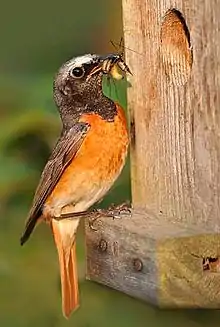
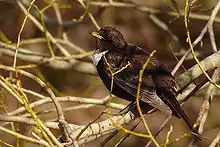
Order: Passeriformes Family: Turdidae
The thrushes and chats are plump, soft-plumaged, small to medium-sized insectivores or sometimes omnivores, often feeding on the ground. Many have attractive songs.
| Common name | Binomial | Status |
|---|---|---|
| Swainson's thrush | Catharus ustulatus | (A) |
| Grey-cheeked thrush | Catharus minimus | (A) |
| Song thrush | Turdus philomelos | |
| Mistle thrush | Turdus viscivorus | (A) |
| Redwing | Turdus iliacus | |
| Blackbird | Turdus merula | |
| Eyebrowed thrush | Turdus obscurus | (A) |
| Fieldfare | Turdus pilaris | |
| Ring ouzel | Turdus torquatus | |
| Black-throated thrush | Turdus atrogularis | |
| Red-throated thrush | Turdus ruficollis | (A)[41] |
| Dusky thrush | Turdus eunomus | (A) |
| American robin | Turdus viscivorus | (A) |
Old World flycatchers

Order: Passeriformes Family: Muscicapidae
The flycatchers are small birds that fly out from a perch to catch insects in the air.
| Common name | Binomial | Status |
|---|---|---|
| Spotted flycatcher | Muscicapa striata | |
| Robin | Erithacus rubecula | |
| Bluethroat | Luscinia svecica | (A) |
| Thrush nightingale | Luscinia luscinia | (A) |
| Nightingale | Luscinia megarhynchos | (A) |
| White-throated robin | Irania gutturalis | (A) |
| Red-flanked bluetail | Tarsiger cyanurus | (A) |
| Red-breasted flycatcher | Ficedula parva | (A) |
| Pied flycatcher | Ficedula hypoleuca | |
| Collared flycatcher | Ficedula albicollis | (A) |
| Black redstart | Phoenicurus ochruros | |
| Redstart | Phoenicurus phoenicurus | |
| Moussier's redstart | Phoenicurus moussieri | (A) |
| Rock thrush | Monticola saxatilis | (A) |
| Blue rock thrush | Monticola solitarius | (A) |
| Whinchat | Saxicola rubetra | |
| Stonechat | Saxicola torquata | |
| Wheatear | Oenanthe oenanthe | |
| Isabelline wheatear | Oenanthe isabellina | (A) |
| Desert wheatear | Oenanthe deserti | (A) |
| Western black-eared wheatear | Oenanthe hispanica | (A) |
| Pied wheatear | Oenanthe pleschanka | (A) |
Dippers
Order: Passeriformes Family: Cinclidae
Dippers are a group of perching birds whose habitat includes aquatic environments in the Americas, Europe and Asia. They are named for their bobbing or dipping movements.
| Common name | Binomial | Status |
|---|---|---|
| Dipper | Cinclus cinclus |
Old World sparrows

Order: Passeriformes Family: Passeridae
Sparrows tend to be small, plump, brownish or greyish birds with short tails and short, powerful beaks. They are seed-eaters and they also consume small insects.
| Common name | Binomial | Status |
|---|---|---|
| Tree sparrow | Passer montanus | |
| Spanish sparrow | Passer hispaniolensis | (A) |
| House sparrow | Passer domesticus |
Accentors
Order: Passeriformes Family: Prunellidae
A small family of drab, unobtrusive, insectivorous birds with thin, pointed bills.
| Common name | Binomial | Status |
|---|---|---|
| Alpine accentor | Prunella collaris | (A) |
| Dunnock | Prunella modularis |
Wagtails and pipits
.jpg.webp)
Order: Passeriformes Family: Motacillidae
Motacillidae is a family of small passerine birds with medium to long tails. They are slender, ground-feeding insectivores of open country.
| Common name | Binomial | Status |
|---|---|---|
| Western yellow wagtail | Motacilla flava | (A) |
| Eastern yellow wagtail | Motacilla tschutschensis | (A) |
| Citrine wagtail | Motacilla citreola | (A) |
| Grey wagtail | Motacilla cinerea | |
| White wagtail | Motacilla alba | |
| Richard's pipit | Anthus richardi | |
| Blyth's pipit | Anthus godlewskii | (A)[26] |
| Tawny pipit | Anthus campestris | (A) |
| Meadow pipit | Anthus pratensis | |
| Tree pipit | Anthus trivialis | |
| Olive-backed pipit | Anthus hodgsoni | (A) |
| Pechora pipit | Anthus gustavi | (A) |
| Red-throated pipit | Anthus cervinus | (A) |
| Buff-bellied pipit | Anthus rubescens | (A) |
| Water pipit | Anthus spinoletta | |
| Rock pipit | Anthus petrosus |
Finches, euphonias, and allies
.jpg.webp)
Order: Passeriformes Family: Fringillidae
Seed-eating passerine birds that are small to moderately large and have a strong beak, usually conical and in some species very large.
| Common name | Binomial | Status |
|---|---|---|
| Chaffinch | Fringilla coelebs | |
| Brambling | Fringilla montifringilla | |
| Hawfinch | Coccothraustes coccothraustes | |
| Bullfinch | Pyrrhula pyrrhula | |
| Common rosefinch | Carpodacus erythrinus | (A) |
| Greenfinch | Chloris chloris | |
| Twite | Linaria flavirostris | |
| Linnet | Linaria cannabina | |
| Common redpoll | Acanthis flammea | (A) |
| Lesser redpoll | Acanthis cabaret | |
| Arctic redpoll | Acanthis hornemanni | (A) |
| Common crossbill | Loxia curvirostra | |
| Two-barred crossbill | Loxia leucoptera | (A) |
| Goldfinch | Carduelis carduelis | |
| Serin | Serinus serinus | (A) |
| Siskin | Spinus spinus |
Longspurs and arctic buntings
Order: Passeriformes Family: Calcariidae
The Calcariidae are a family of birds that had been traditionally grouped with the New World sparrows, but differ in a number of respects and are usually found in open grassy areas.
| Common name | Binomial | Status |
|---|---|---|
| Lapland bunting | Calcarius lapponicus | |
| Snow bunting | Plectrophenax nivalis |
Old World buntings
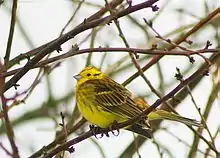
Order: Passeriformes Family: Emberizidae
The Emberizidae are a large family of seed-eating passerine birds with a distinctively shaped bill.
| Common name | Binomial | Status |
|---|---|---|
| Corn bunting | Emberiza calandra | (A) |
| Yellowhammer | Emberiza citrinella | |
| Pine bunting | Emberiza leucocephalos | (A) |
| Rock bunting | Emberiza cia | (A) |
| Ortolan bunting | Emberiza hortulana | (A) |
| Cretzschmar's bunting | Emberiza caesia | (A) |
| Cirl bunting | Emberiza cirlus | (A) |
| Little bunting | Emberiza pusilla | (A) |
| Rustic bunting | Emberiza rustica | (A) |
| Yellow-breasted bunting | Emberiza aureola | (A) |
| Black-headed bunting | Emberiza melanocephala | (A) |
| Reed bunting | Emberiza schoeniclus |
New World sparrows
Order: Passeriformes Family: Passerellidae
Until 2017, these species were considered part of the family Emberizidae. Most of the species are known as sparrows, but these birds are not closely related to the Old World sparrows which are in the family Passeridae. Many of these have distinctive head patterns.
| Common name | Binomial | Status |
|---|---|---|
| Dark-eyed junco | Junco hyemalis | (A) |
| White-throated sparrow | Zonotrichia albicollis | (A) |
| Song sparrow | Melospiza melodia | (A) |
Troupials and allies
Order: Passeriformes Family: Icteridae
A group of small to medium-sized, often colourful passerine birds restricted to the New World.
| Common name | Binomial | Status |
|---|---|---|
| Bobolink | Dolichonyx oryzivorus | (A) |
| Baltimore oriole | Icterus galbula | (A) |
| Brown-headed cowbird | Molothrus ater | (A) |
New World warblers

Order: Passeriformes Family: Panuridae
A group of small, often colourful passerine birds restricted to the New World. Most are arboreal and insectivorous.
| Common name | Binomial | Status |
|---|---|---|
| Black-and-white warbler | Mniotilta varia | (A) |
| Common yellowthroat | Geothlypas trichas | (A) |
| Blackburnian warbler | Setophaga fusca | (A) |
| Yellow warbler | Setophaga petechia | (A) |
| Blackpoll warbler | Setophaga striata | (A) |
| Yellow-rumped warbler | Setophaga coronata | (A) |
Cardinals and allies
Order: Passeriformes Family: Cardinalidae
The cardinals are a family of robust, seed-eating birds with strong bills. They are typically associated with open woodland. The sexes usually have distinct plumages.
| Common name | Binomial | Status |
|---|---|---|
| Summer tanager | Piranga rubra | (A) |
| Rose-breasted grosbeak | Pheucticus ludovicianus | (A) |
| Indigo bunting | Passerina cyanea | (A) |
See also
Footnotes
- 1 2 Pugh (2005)
- 1 2 3 4 5 O'Shea (2000)
- ↑ Tipling (1996)
- ↑ British Ornithologist's Union (2008)
- ↑ Dudley et al. (2006)
- ↑ Lovegrove et al. (1994), p63
- ↑ Lovegrove et al. (1994), p75
- ↑ Lovegrove et al. (1994), p85
- ↑ Green (2002), p86
- ↑ Many or all records of Egyptian goose and ring-necked parakeet may refer to escapes from captivity rather than feral wanderers from England (Prater & Thorpe 2006).
- ↑ Rogers & the BBRC (2004)
- ↑ First recorded November 2005 (WRP 2006)
- ↑ Green (2002), p172
- ↑ Lovegrove et al. (1994), p38
- 1 2 3 Lovegrove et al. (1994)
- ↑ Green (2002), p119
- ↑ Lovegrove et al. (1994), p160
- ↑ O'Shea (2000), p89
- ↑ First recorded July 2006 (WRP2007)
- ↑ Lovegrove et al. (1994), p190
- ↑ Green (2002), p164
- ↑ Green (2002), p171
- ↑ Lovegrove et al. (1994), p44
- ↑ Green (2002), p61
- ↑ Evans (2003)
- 1 2 First recorded October 2005 (WRP 2006)
- ↑ Lovegrove et al. (1994), p119-121
- ↑ O'Shea (2000), p129
- ↑ Lovegrove et al. (1994), p236
- ↑ Green (2002), p181
- ↑ Lovegrove et al. (1994), p128
- ↑ Green (2002), p226
- ↑ Lovegrove et al. (1994), p307
- ↑ Green (2002), p185
- ↑ Gill, F. and D. Donsker (Eds). 2019. IOC World Bird List (v 9.2). doi:10.14344/IOC.ML.9.2. http://www.worldbirdnames.org/ retrieved 22 June 2019.
- ↑ First recorded October 2006 (WRP 2007)
- ↑ Lovegrove et al. (1994), p259
- ↑ Lovegrove et al. (1994), p310
- ↑ Lovegrove et al. (1994), p265
- ↑ Lovegrove et al. (1994), p272
- ↑ First recorded December 2005 (WRP 2006)
- ↑ Lovegrove et al. (1994), p299
- ↑ Lovegrove et al. (1994), p326
- ↑ Lovegrove et al. (1994), p249
- ↑ Green (2002), p240
- ↑ Snow & Perrins (1998), p1618
References
- Lepage, Denis. "Checklist of Birds of Wales". Bird Checklists of the World. Avibase. Retrieved 27 August 2021.
- British Birds Rarities Committee (2006) BBRC says goodbye to birders favourites. Accessed 22 April 2008.
- British Ornithologists' Union (2008) The British List: the official list of bird species recorded in Great Britain. Archived 2008-05-07 at the Wayback Machine. Accessed 22 April 2008.
- Clements, James F. (2007) The Clements Checklist of Birds of the World, 6th ed., Cornell University Press, Ithaca, New York.
- Dudley, Steve P.; Mike Gee; Chris Kehoe; Tim M. Melling; The British Ornithologists' Union Records Committee (BOURC) (2006) The British List: A Checklist of Birds of Britain (7th edition), Ibis, 148 (3): 526–563.
- Evans, Ceri (2003) Introduction to the species audit for Wales (phase 2) and species groups. Accessed 22 April 2008.
- Green, Jonathan (2022) Birds in Wales 1992–2022, Welsh Ornithological Society.
- Lovegrove, Roger; Graham Williams & Iolo Williams (1994) Birds in Wales, T & AD Poyser Ltd, London.
- O'Shea, Brian (2000) In Search of Birds in Wales, Skylark Books, Aberystwyth.
- Perrins, Christopher, ed. (2004) The New Encyclopedia of Birds, Oxford University Press, Oxford.
- Prater & Thorpe (2006) Welsh Species List. Accessed 22 April 2008.
- Pugh, Elfyn (2005) The Red Kite Archived 2010-01-30 at the Wayback Machine, Birds of Britain. Accessed 22 April 2008.
- Rogers, M. J. & the British Birds Rarities Committee (2004) Report on Rare birds in Great Britain in 2003, British Birds, 97:564.
- Snow, D. W. & Perrins, C. M. (1998) Birds of the Western Palearctic: Concise Edition, Vol. 2, Oxford University Press, Oxford.
- Tipling, David (1996) Top Birding Spots in Britain & Ireland, HarperCollins, London.
- Welsh Records Panel (2006) Scarce and rare birds in Wales 2005. Accessed 22 April 2008.
- Welsh Records Panel (2007) Scarce and rare birds in Wales 2006. Accessed 22 April 2008.
